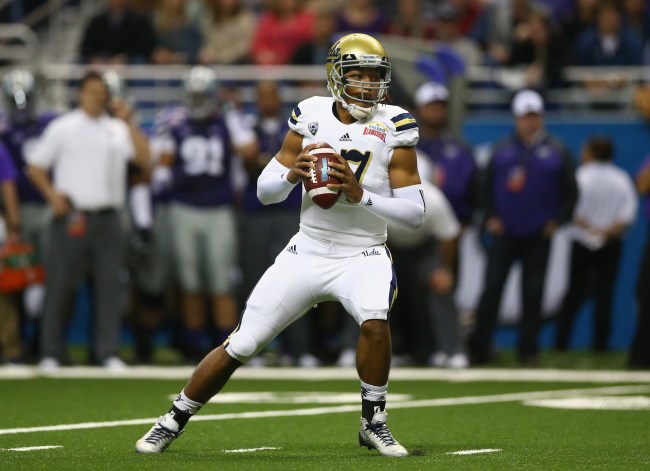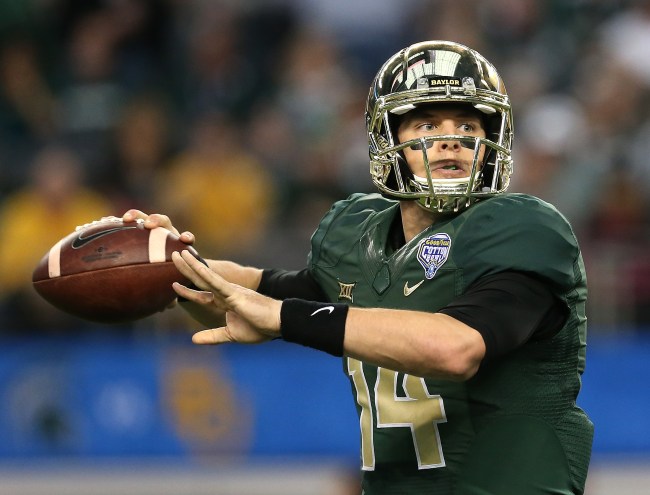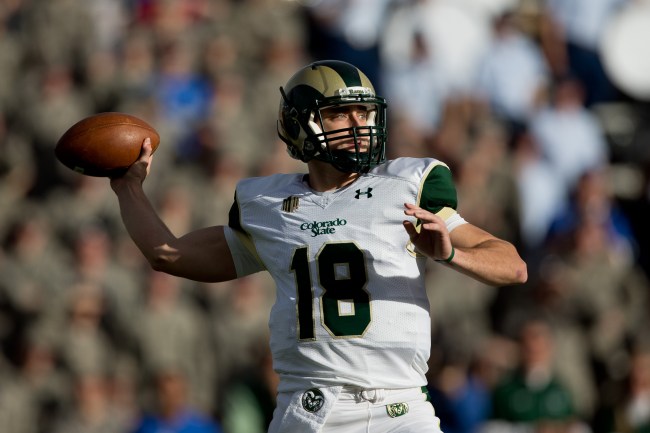
The common wisdom of the 2015 NFL Draft currently says that the Tampa Bay Buccaneers will draft Jameis Winston with the first overall pick on Thursday, and Marcus Mariota won’t fall past the Jets at the sixth pick (though if the Philip Rivers trade happens, then he won’t fall past No. 2). But blue-chip first rounders aren’t the only quarterbacks that get drafted, and they aren’t the only ones that play either.
Tom Brady and Russell Wilson are the most famous examples of overlooked QBs to make splashes in the NFL, mostly because they were immediately effective and have won Super Bowls. But the situations they found themselves in happen more often than you think — an NFL team either doesn’t have the picks to get a top-flite QB and settles for a second-tier project, or they think they’re set at the position and draft for a backup, only to see injury or ineffectiveness thrust the unproven commodity into the spotlight.
In last year’s draft, Zach Mettenberger was drafted in the sixth round by the Titans and started six games of his rookie season. He’s no Brady or Wilson, but he showed enough skill to be considered a reasonable backup, which will allow him to stick around the league for years. And Derek Carr was a tier below Teddy Bridgewater, Blake Bortles and Johnny Manziel, but he started more games than all of them.
By all accounts, there’s a larger drop-off this year between the first and second tiers of quarterback prospects than last year, mostly because of how much better scouts think Winston and Mariota are than anybody from last year. As a result, not a lot of discussion has been given to any other quarterback outside of hardcore draftnik circles.
In those circles, however, a clear three-man second tier has emerged, with no consensus about which of the three has the upper hand. So let’s see who they are, and what we know about them.
Brett Hundley, UCLA

Hundley has the most name recognition on this list, in part because of how highly he was regarded coming out of high school. What scouts/draft prognosticators think of him depends largely on what they value — he’s 6’3 and around 220 pounds, which is good size for the position, he’s fast and willing to run, but not very elusive. He has a lot of arm strength and he’s accurate enough, but isn’t NFL-ready in terms of his downfield reads and his pocket awareness; nor has he done much work under center.
That’s where everyone agrees — all the physical tools one could want in a quarterback, without any of the “pro-ready” qualities, so he wouldn’t be ready to start as a rookie. What varies is the level of optimism over his ability to develop his skills to match his talents. I’d personally be shocked if he falls out of the third round, but equally shocked if he gets picked before the back half of the second. Sometimes those physical gifts are too tough to resist.
Bryce Petty, Baylor

Petty had big shoes to fill as RGIII’s successor at Baylor, but he’s a completely different kind of quarterback. He’s not as athletic or willing to run as Hundley, but he’s about the same size and has the same issues with his college’s offense not preparing him for the NFL. Everyone seems to think he had a good pro day, showing off accuracy on every kind of throw. The universal concerns are the college offense and his steep drop-off in effectiveness if he’s pressured or forced to move in the pocket.
The difference in opinion on Petty is representative of how headache-inducing the pre-draft process can be for a fan of pro football who doesn’t watch much of the college game. CBS Sports says he “doesn’t throw for a high percentage downfield and often throws up passes that can be best categorized as 50-50 balls,” whereas NFL.com says that he “rarely underthrows deep passes, preferring to give only his wide receiver a chance to catch the ball.” So someone got sent the wrong tape or something, right? Either way, Petty profiles as another QB who won’t be ready on Day 1, and where scouts rank him in relation to Hundley once again depends on their gut feelings.
Garrett Grayson, Colorado State

If both Petty and Hundley were enticing prospects entering 2014 who didn’t help their causes, Grayson was the opposite, rising continuously from an impressive senior season to a good Senior Bowl to a solid Combine showing. He stands in contrast to Hundley and Petty as a prospect who has shown A) the ability to operate from under center, B) excellent pocket presence, and C) in-game accuracy all over the field.
He’s consistently knocked for having a hitch in his delivery that slows down his release, and combined with his sub-elite arm strength, that means he doesn’t do well on throws that need to be delivered quickly, like out routes to the sideline. He has been praised all over for keeping good footwork while throwing on the run, but here’s another fun choice: do you believe when CBS Sports says that Grayson “attempts to lead receivers away from hits, showing above average accuracy in doing so,” or do you believe when NFL.com says that he “will run his receivers into big collisions at times”?
Grayson’s an interesting case, because the concerns scouts voice about him — top-level arm strength, unorthodox delivery — seem to be the kind of issues that pop up in “how did we miss this guy?” conversations down the road. That’s not to say that Grayson is more of a sure thing than Hundley or Petty, since every single positive or negative descriptor of a draft prospect has turned out to be prescient in some cases and overblown in others, but my uneducated, gut feeling would be that Grayson is the mid-round QB I’d go for.






